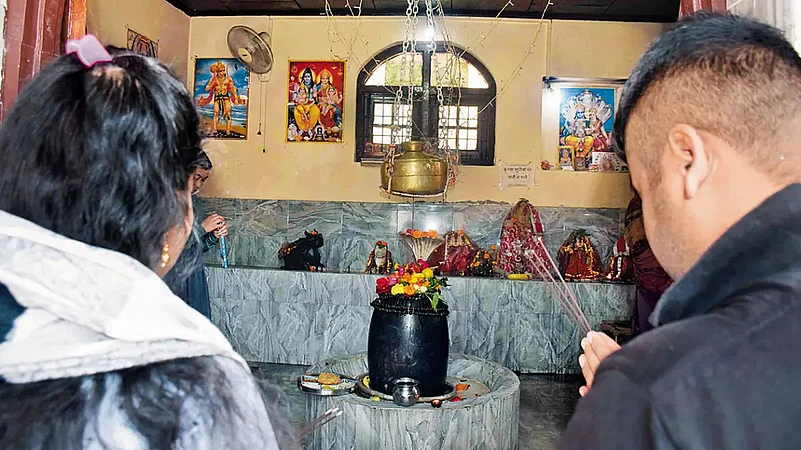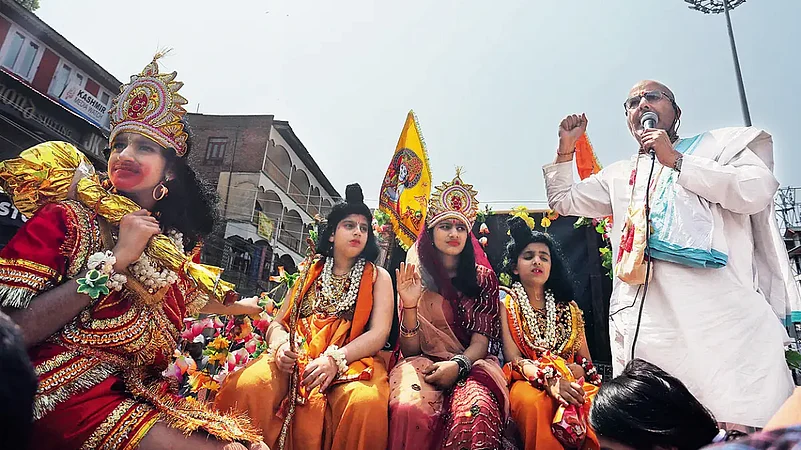For Kashmiri Pandits, Kashmir has been essentially a Shaivite land for centuries. Several verses of Lalleshwari or Lal Ded (1320-92), Kashmir’s best-known spiritual and literary figure, are testimony to the prevalence of Shiva in the Valley. Kashmiri Pandits and scholars of Kashmiri Shaivism like M.H. Zafar say that Shiva has had a higher position in the pantheon of Kashmiri Pandit traditions for many generations. Ram arrived as a deity in the land of the chinars only during the Dogra rule in the mid-19th century.
“Here you’ll find Shiva temples that are 3,500 years old,” says Sanjay Tickoo, president of the Kashmiri Pandit Sangharsh Samiti.
Advertisement
Underlining that Pandits are worshippers of Shiva and Shakti, Tickoo says worship of Ram started after the Dogra rulers (1846-1947) erected temples dedicated to Ram in the Valley, including the Berber Shah temple.
Along with the temples arrived festivals like Ram Navami and Dussehra. “Besides the Dogra rulers, Hindus who came from Lahore before and after the Partition also established Ram temples in the Valley,” he says.
ALSO READ: Who Is Ram And What Is His Story?
Author Bansi Pandit offers another perspective. Since the 10th century AD, the dominant faith of Pandits has been Kashmiri Shaivism, with Shiva considered the ‘ultimate reality’, he says. “As an unmanifest reality, Shiva is pure consciousness, the source of all matter (or energy) in the universe. All other deities worshipped by Hindus are different forms of Shiva. Ram was worshipped not as a special deity, but as a form of Shiva,” he says. The practice changed when the Dogras became the rulers.
Advertisement
“The Dogra rulers are said to be the descendants of the Suryavashi dynasty, to which Lord Ram belonged. They worshipped Lord Ram as their chosen deity. Thus, the Raghunath and Ram temples were constructed in the Valley to draw inspiration from his brave and considerate deeds,” he says.

“As is the king, so are his subjects. Thus, Kashmiris began worshipping Ram, which gave birth to Rama Kavya in Kashmir. Seven Ramayanas, besides miscellaneous songs of nature, have been written since then,” he says.
ALSO READ: Who Is Ram? Defining The Enigma
It marked the second major emphasis of Hindu deities in Kashmir in the last several centuries. In the first instance, as Zafar underlines, Lal gave a new lease of life to the Kashmiri Shaivistic spiritual tradition and demystified Shaivism by articulating its tenets in the language of the common people. In the second phase, enabled by kingly support, Ram gained some space in the Shaivite land.
The Ramayana that became the most popular is Ramavatar Charita of Prakash Ram (1819-85), the first Ramayana written in the Kashmiri language. Ramavatar Charita released the streams of Bhakti (divine love) in Kashmir, just as Ramcharitamanas of Tulsidas did in north India, about 400 years earlier, says Bansi Pandit.
Advertisement
In her book, Hindu Rulers, Muslim Subjects: Islam, Rights, and the History of Kashmir, Mridu Rai argues that Dogra ruler Ranbir Singh began to “embed aspects of the Rama cult in the Valley in order to associate Jammu and Kashmir within a common frame of worship.” She writes, “One way in which the Dogras did this was by erecting temples dedicated to Vaishnavite, especially Ram, worship on Kashmiri soil.”
Advertisement
Poet and author Ranjit Hoskote agrees. “My sense is that the cult of Sri Ram in Kashmir is rather recent; indeed, no older than the Dogra rule. The Pandits are largely Shaiva in orientation; the Dogra rulers, upon their accession in the Valley, demanded, of the Pandits, a certain obeisance to their (the Dogras’) Vaishnava predilections.”
It marked a major addition to the theistic tradition in Kashmir. Before the arrival of Ram, all deities of the Hindu pantheon were worshipped as manifestations of Shiva and Shakti.
However, while Ram has arrived in Kashmir, Shiva continues to be the primary deity of Kashmiri Hindus. Shivratri is still their biggest festival, with even Janmashtami considered more significant than Ram Navami. Consequently, there are more Shiva temples across the Valley than Ram temples, as the religious philosophy of Kashmiri Pandits continues to be rooted in Kashmiri Shaivism.
Advertisement
There are also some divergent views. Professor Ashok Koul, a resident of Bandipora district in north Kashmir who now teaches anthropology at the Banaras Hindu University, says: “To my mind, Ramayana in Kashmir is as old as Kashmiri Shaiva tradition, as it has moved from generation to generation. Ram stands for your deeds. We consider Iqbal a Kashmiri poet, and he considered Ram as Imam-e-Hind,” Koul says.
Koul refers to Iqbal’s poem Ram, where the latter called the deity Imam-e-Hind, in whose existence all of India takes pride.
Advertisement
Hai Ram ke vajud pe Hindostan ko naaz
ahl-e-nazar samajhte hain is ko Imam-e-Hind
(India is proud of the existence of Ram
Spiritual people consider him their prelate)
“Formally, we might be Shaivites, but we live in a syncretic tradition, and Ram figures prominently in our lives. If Kashmiris are left to themselves, we will live in a society where Islamic traditions are as much respected as Shaivite and non- Shaivite traditions,” he says.
(This appeared in the print edition as "The Coming of Ram in the Valley")
Naseer Ganai in Srinagar




















